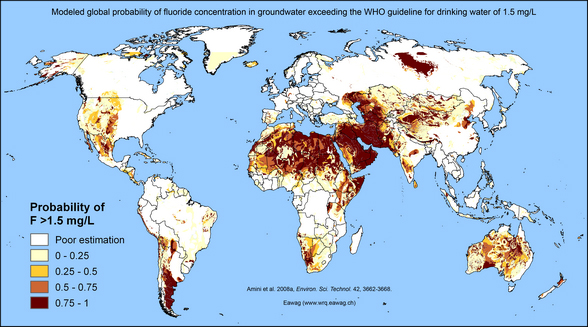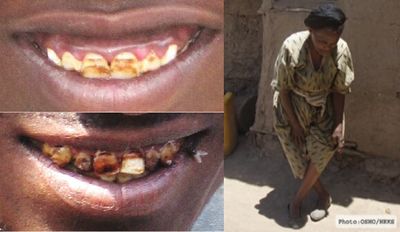Geogenic contamination - Fluoride
NOTE: Modified article from the Geogenic Contamination Handbook
Occurrence
Ultramafic rocks deficient in silica (SiO2) have relatively low fluoride content (100 mg/kg), whereas intermediate rocks have an average concentration of ~400 mg/kg and felsic igneous rocks, which contain high concentrations of SiO2, tend to have even higher fluoride concentrations (around 1000 mg/kg). Fluoride tends to be associated with micas in igneous rocks, has a strong association with phosphates in both primary and secondary minerals and sorbs to clays and aluminium hydroxides secondary weathering products (Wedepohl 1978). Geochemical conditions largely control the concentration of fluoride in aquifer systems. Figure "Geochemical processes that control fluoride solubility. a) The precipitation of fluorite" illustrates the dependence of fluoride concentration on calcium concentration in a system where fluorite (CaF2(s)) precipitation controls the amount of dissolved fluoride. Assuming the source of calcium to be calcite at atmospheric PCO2, a calcium concentration of 20 mg/L would be expected. Calcium concentrations are higher at higher partial pressures of CO2, which further drive down fluoride concentrations that may be additionally limited by sorption to sediment minerals. In poorly pH-buffered systems with low pH, such as in association with low-calcium felsic rocks, there may be little control of dissolved fluoride content. For example, high-fluoride minerals in granitic rocks cause elevated dissolved fluoride concentrations in India and Sri Lanka.
Health effects
Fluoride has beneficial effects on teeth at low concentrations, but excessive exposure to fluoride can have a number of adverse effects, such as dental and skeletal fluorosis, the severity of which depends on the level and duration of exposure (Gazzano et al., 2010). Worldwide, an estimated 200 million people are at risk of fluorosis. However, incomplete data make precise quantification of the global health burden of fluorosis impossible (Fewtrell, 2006).
Childhood exposure to fluoride concentrations in drinking water that exceed the WHO guideline limit of 1.5 mg/L can lead to dental fluorosis (Fig. 2.6), a condition characterised by the mottling and pitting of teeth. Dental fluorosis occurs in young children as the tooth enamel is developing (NRC, 2006). Fluoride ingestion after about the age of 8, when adult teeth have been formed (even if they have not yet erupted), will not lead to dental fluorosis. Adults with dental fluorosis must therefore have been exposed to high fluoride concentrations in their early childhood. Symptoms of mild dental fluorosis are the appearance of white striations or patches on the tooth enamel, while yellow and brown staining, pitting and chipping of the tooth enamel are symptoms of more severe fluorosis. Dental mottling is permanent, though some cosmetic treatment (bleaching, abrasion) can remove some of the visible stains.
Prolonged exposure to high fluoride concentrations over several years increases the risk of developing crippling skeletal fluorosis. This condition is characterised by pain and stiffness in the backbone and joints, accompanied by increased bone density (osteosclerosis). In its later stages, crippling deformities of the spine and joints arise, together with neurological defects, muscle wasting and paralysis (Oszvath, 2009). Studies on occupational and endemic fluorosis have shown that the extent of the symptoms is related to the duration and level of exposure and that skeletal fluorosis is at least partially reversible over a number of years. (e.g. Grandjean, 1982; Krishnamachari, 1986; Susheela and Bhatnagar, 2000). In addition to these more obvious symptoms, there are others grouped under the term “non-skeletal fluorosis”. Non-skeletal fluorosis includes a reported decrease in cognitive capacity (measured by IQ tests), lethargy, an impaired ability to concentrate and possibly even the onset of dementia (USRC, 2006). Whether these effects could be due to enzymatic changes or impaired function of the thyroid gland is unclear. Fluoride may also disturb the endocrine system, acting as an inhibitor of secretions from the parathyroid glands, which regulate extracellular calcium and phosphate concentrations. Possible effects on the gastrointestinal, renal, hepatitic and immune systems have also been reported (USRC, 2006). There has been difficulty in proving observed health effects (in scientific studies) to be the result of elevated fluoride intake, and more rigorous epidemiological studies have been recommended.
The WHO guideline value of 1.5 mg/L might not be suitable for hot, arid areas where people have a higher daily water intake (Brouwer et al., 1988). The recommended maximal daily fluoride intake for children younger than 8 years (to prevent dental and skeletal fluorosis) is 0.1 mg/day per kg of body weight (SCSEDRI, 1997, Table 3.3). For adults, a daily intake of 14 mg leads to an excess risk of adverse skeletal fluorosis, and there is evidence for increased risk of an effect on the skeleton at an intake of 6 mg/day (Fawell et al., 2006). Not only drinking water, but also cooking water and fluoride contained in food products can contribute considerably to a person’s daily fluoride uptake (Malde et al., 2011). Skeletal effects in fluorotic areas may vary in severity depending not only on the daily fluoride uptake, but also on the intake of other essential nutrients important for bone formation, such as calcium, zinc, iron and magnesium. Deficient nutrition will therefore increase the risk of bone deformation when excess fluoride is consumed (Chakma et al., 2000).
References
For references, please visit the page References - Geogenic Contamination Handbook.


